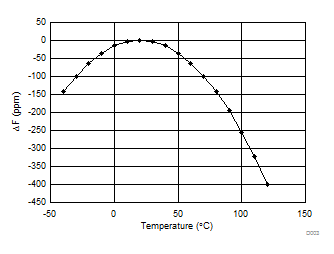SWRA495K December 2015 – April 2024 CC1310 , CC1350 , CC2620 , CC2630 , CC2640 , CC2640R2F , CC2640R2F-Q1 , CC2642R-Q1 , CC2650 , CC2662R-Q1
- 1
- Abstract
- Trademarks
- 1Oscillator and Crystal Basics
- 2Overview of Crystal Oscillators for CC devices
- 3Selecting Crystals for the CC devices
- 4PCB Layout of the Crystal
- 5Measuring the Amplitude of the Oscillations of Your Crystal
- 6Crystals for CC13xx, CC26xx and CC23xx
- 7High Performance BAW Oscillator
- 8References
- 9Revision History
3.2.2 32.768-kHz Crystal
The 32.768-kHz crystal oscillator is used as the Read Time Clock (RTC) and is kept running when the device is in Standby mode. Because Bluetooth® low energy is a time-synchronized protocol, an accurate clock also enables longer periods of time in a low-power mode. If a lower-accuracy crystal is used, the device must wake up early to accommodate for the lower accuracy of the clock. To be compliant with Bluetooth® low energy, the clock must have a maximum of ±500 ppm of inaccuracy. For more information, see [2]. TI recommends using a tighter tolerance 32.768-kHz crystal to reduce the average power consumption in a typical Bluetooth® low energy connection. In the SimpleLink™ CC2650 EVM Kit 4XD (CC2650EM-4XD) v1.0.3 Design Files, TI uses the Epson FC-135 crystal. If a crystal with different specifications is used, this setting must be adjusted for in the Bluetooth® low energy stack. For more details, see the BLE Stack Users Guide.
Note that low-frequency tuning fork crystals have a resonance frequency that changes with temperature with a parabolic coefficient of (–0.04 × 10– 6) / °C2 typically. Figure 3-1 shows an example of this . In Figure 3-1, 40-ppm accuracy is maintained only from –10°C to 50°C.
 Figure 3-1 Typical
Frequency vs Temperature Curve for a 32.768-kHz Tuning Fork
Crystal
Figure 3-1 Typical
Frequency vs Temperature Curve for a 32.768-kHz Tuning Fork
Crystal